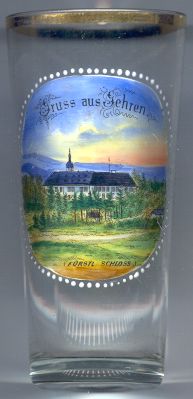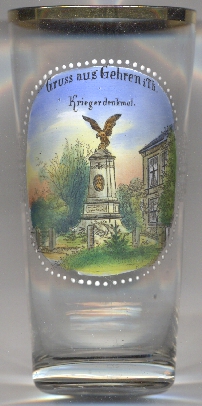

|
| DEUTSCHLAND | GERMANY |
| Bundesland: Freistaat Thüringen | Thuringia |
| Landkreis: Ilm-Kreis |
Gehren is situated at an elevation of 498 m at the northern slope of the Langer Berg in the Ilm-Kreis (Ilm district) of Thuringia. Gehren has a population of about 3,800 (2003) and is the seat of the administrative union Langer Berg, the common administration for the municipalities Gehren, Herschdorf, Möhrenbach, Neustadt am Rennsteig and Pennewitz.
The earliest settlers seemed to have come to this area in the 12th century, the earliest mention in a document dates from 1299. The ironworks on the Günthersfeld were founded in 1486. When Count Heinrich XXXVII of Schwarzburg-Arnstadt and Rudolstadt converted to the Protestant faith, the Reformation was also introduced in Gehren. At some time between 1533 and 1549 Gehren obtained the status of a market town.With the formal division in 1599 of the Schwarzburg territories, Gehren became part of the county Schwarzburg-Arnstadt (1698 principality, 1716 renamed Schwarzburg-Sondershausen). During the Thirty Years' War (1618–1648) the town was looted several times by Imperial and Swedish troops. In addition, the Plague killed several hundred of the inhabitants between 1625 and 1636. Michael Bach, father-in-law of Johann Sebastian Bach worked here as town chronicler and organist from 1673 until 1694. In 1749 a large fire destroyed about one third of the town. During the Napoleonic times (1805–1814) Gehren suffered even more than before. In 1855 Gehren was finally chartered as a town. The railroad from Ilmenau to Großbreitenbach via Gehren was opened in 1883.

 Castle Gehren [left, no. 2075] goes back to a watchtower that was founded here around 1300. Around
1460 the counts of Schwarzburg built the south wing of the castle. About a century later, in 1574, the castle was enlarged. In the 19th century it
was used as a summer residence by the princely family. In 1869 it was the site of the marriage of Prince Karl Günther of Schwarzburg-Sondershausen
and Marie, Princess of Saxe-Altenburg. A famous feature of the castle was the fountain, built in 1894 at an enormous cost. The
doll collection "Mon Plaisir", which had been started around 1700 by Princess Auguste Dorothea of Schwarzburg-Arnstadt (Schwarzburg-Sondershausen), was brought to
the castle of Gehren in 1892. In 1930 the collection was transfered to Arnstadt, which was a great luck because only three years
later the castle was devastated by fire and never could be restored.
Castle Gehren [left, no. 2075] goes back to a watchtower that was founded here around 1300. Around
1460 the counts of Schwarzburg built the south wing of the castle. About a century later, in 1574, the castle was enlarged. In the 19th century it
was used as a summer residence by the princely family. In 1869 it was the site of the marriage of Prince Karl Günther of Schwarzburg-Sondershausen
and Marie, Princess of Saxe-Altenburg. A famous feature of the castle was the fountain, built in 1894 at an enormous cost. The
doll collection "Mon Plaisir", which had been started around 1700 by Princess Auguste Dorothea of Schwarzburg-Arnstadt (Schwarzburg-Sondershausen), was brought to
the castle of Gehren in 1892. In 1930 the collection was transfered to Arnstadt, which was a great luck because only three years
later the castle was devastated by fire and never could be restored.

The  soldiers' monument [near left, no. 4294]
was created by the sculptor Oscar Bodin (1868–1940). Given the life dates of the artist, it is most likely that the monument was created after
World War I (1914–1918).
soldiers' monument [near left, no. 4294]
was created by the sculptor Oscar Bodin (1868–1940). Given the life dates of the artist, it is most likely that the monument was created after
World War I (1914–1918).
[https://institut-aktuelle-kunst.de/kuenstlerlexikon/bodin-oscar]
![[scale]](lineal.jpg)